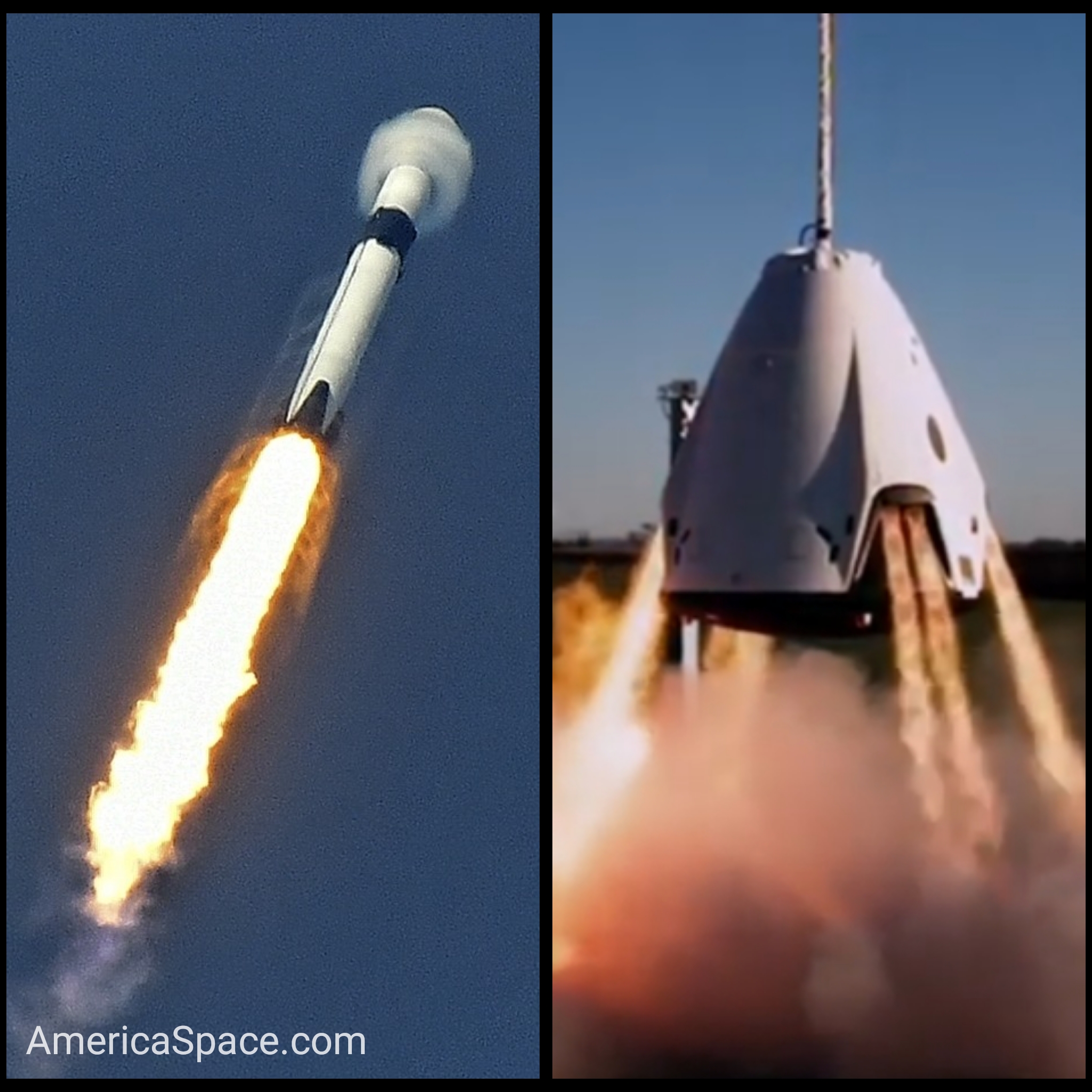
SpaceX already kicked off America’s new decade of spaceflight recently with a picture-perfect launch of their Starlink-2 mission, but their next flight is far more important, because it will be the final major hurdle before NASA certifies SpaceX to begin flying astronauts on their Falcon 9 and Crew Dragon to and from the International Space Station (ISS) beginning later this year.
SpaceX has already flown an uncrewed test to and from the ISS, and tested the spacecraft’s ability to abort from the rocket and launch pad in the event of a ground emergency, but now they will actually launch the capsule to demonstrate its in-flight abort capability, simulating an ascent emergency where the spacecraft would abort safely away to escape from a failing rocket during launch.
Following a successful static test fire today (Jan 11) of the rocket, liftoff is scheduled for 8:00am Eastern time from Kennedy Space Center pad 39A in Florida on Jan 18, at the start of a four-hour test window. Watch LIVE COVERAGE here
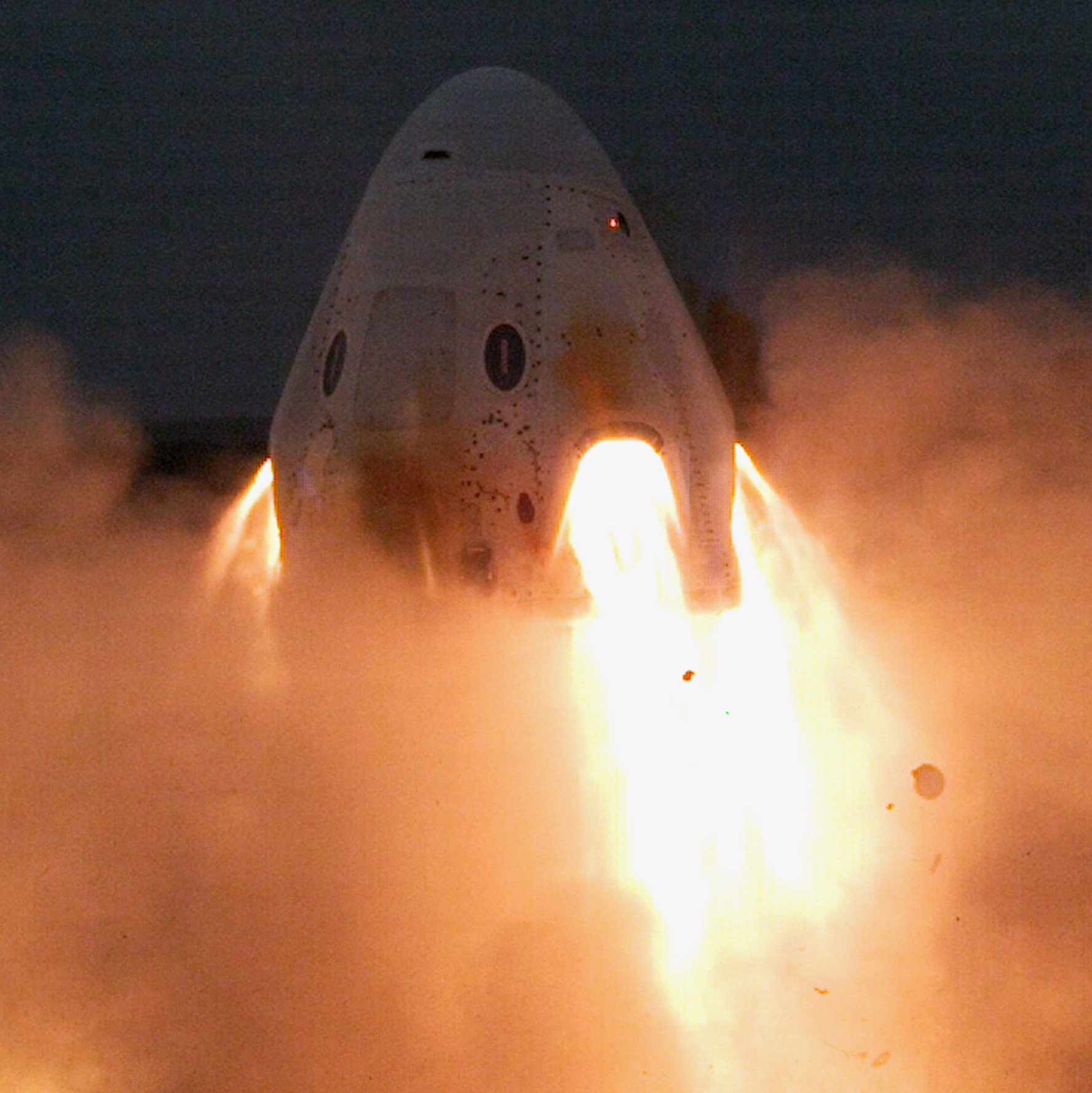
NASA conducted a similar test last year with their Orion Crew Capsule, and a scary incident in 2018 in Russia proved exactly why such a capability is absolutely needed, when the crew of Soyuz MS-10 experienced a failure with their rocket, forcing them into a dangerous high-G ballistic descent back to Earth.
Fortunately they survived, but things easily could have turned out the opposite. Even a proven system like Soyuz can’t escape the inevitable. Things will go wrong, and the upcoming Crew Dragon In-Flight Abort Test will ensure future Dragon crews can safely escape an in-flight emergency.
Additionally, SpaceX has lost two missions to failing rockets in recent years; one on the launch pad (AMOS-6) and one on launch – a Cargo Dragon mission for NASA (CRS-7). And while both NASA and SpaceX are confident that the issues which caused those accidents are resolved, it does not change the fact that those events are exactly why an abort capability is needed for crews to begin with.
They’ve had issues with the spacecraft’s abort system as well, as to be expected with such development programs, yet a reality nonetheless. ast April during testing the Crew Capsule blew up due to a leaky valve which allowed liquid oxidizer – nitrogen tetroxide (NTO) – to enter high-pressure helium tubes.
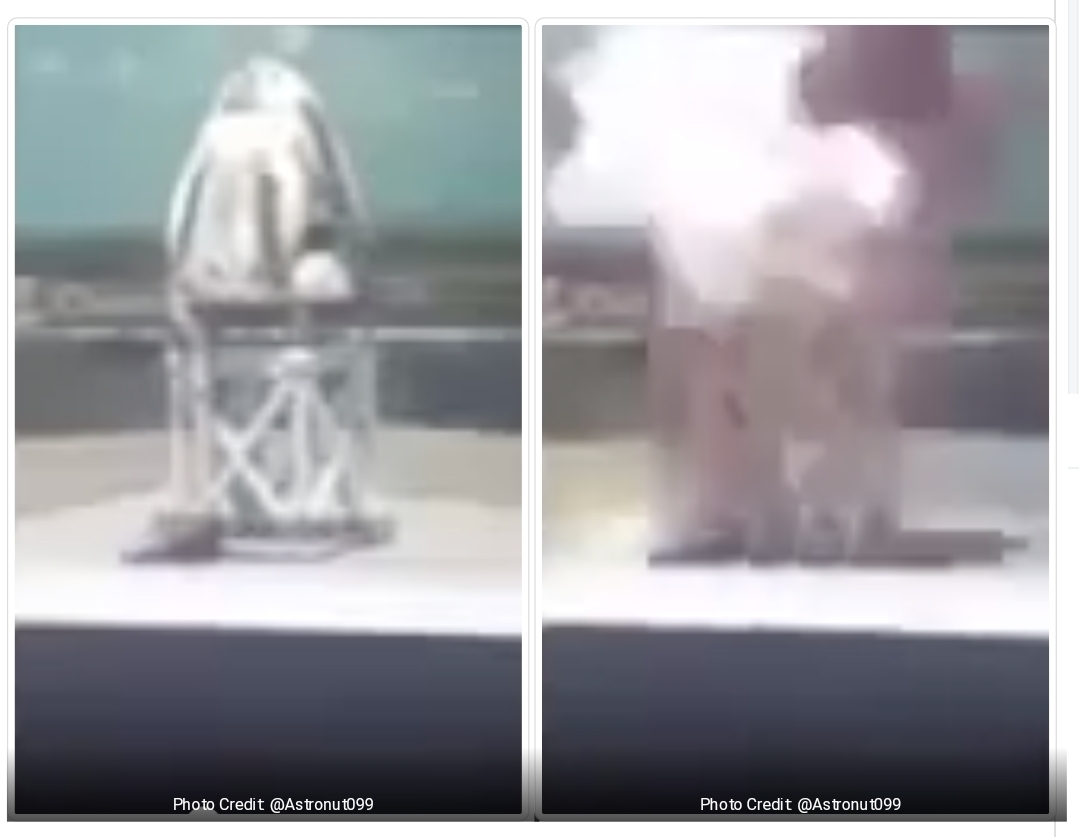
“Personnel determined that a slug of liquid propellant in the high-flow helium pressurization system unexpectedly caused a titanium ignition event resulting in an explosion,” explained NASA in a press release. “Based on that investigation’s findings and months of testing, SpaceX redesigned components of the system to eliminate the possibility of slugs entering the high-flow pressurization system.”
Crew Dragon employs eight SuperDraco thrusters for an abort emergency, which are paired up in pods of four around the spacecraft, with each engine providing a thrust of 16,000 pounds. Fired together at full throttle, the SuperDracos can move the spacecraft 0.5 miles—the length of over 7 American football fields lined up end to end—in 7.5 seconds, reaching a peak velocity of 436 mph according to SpaceX.
The incident delayed Crew Dragon by 7 months, before having another capsule (modified with changes needed following the explosion) undergo the static test fire campaign again and passing with flying colors, which then paved the way to a launch attempt of the In-Flight Abort Test. All total SpaceX has conducted over 700 tests of the launch escape system.
SpaceX already conducted a Pad Abort Test in 2015, which launched from SLC-40 off a specially made truss to simulate the spacecraft atop a Falcon-9 rocket. The 21,000-lb prototype took flight quickly under 120,000 lbs of axial thrust from its eight SuperDraco engines, ascending 3,500 ft in six seconds before jettisoning its trunk and deploying a pair of drogue chutes, followed by a trio of main parachutes and splashdown less than a mile offshore.
The in-flight abort test is not just for the flight itself either. SpaceX and NASA will use it as dress rehearsal for the first crewed launch, practicing launch day end-to-end operations with NASA astronauts, including final spacecraft inspections and side hatch closeout. SpaceX and NASA flight controllers and their support teams will be staged same as for future crewed missions, giving the integrated launch team valuable experience prior to really flying people.
Spac3X will launch Crew Dragon on a reused rocket, flying its 4th and final mission and now destined for the bottom of the Atlantic Ocean. SpaceX will shut down the rocket’s engines at Max-Q to simulate a “loss of thrust”, which will then trigger the spacecraft’s abort. At this point it is still unclear if SpaceX will initiate the rocket’s flight termination system or if they will let the rocket fall on its own, which will likely result in it being torn apart by aerodynamic forces at such speed.
.
Below are some details about the upcoming Ascent Abort Test
.
The following is from the FAA’s “Draft Environmental Assessment for Issuing SpaceX a Launch License for an In-flight Dragon Abort Test”, issued in November 2018:
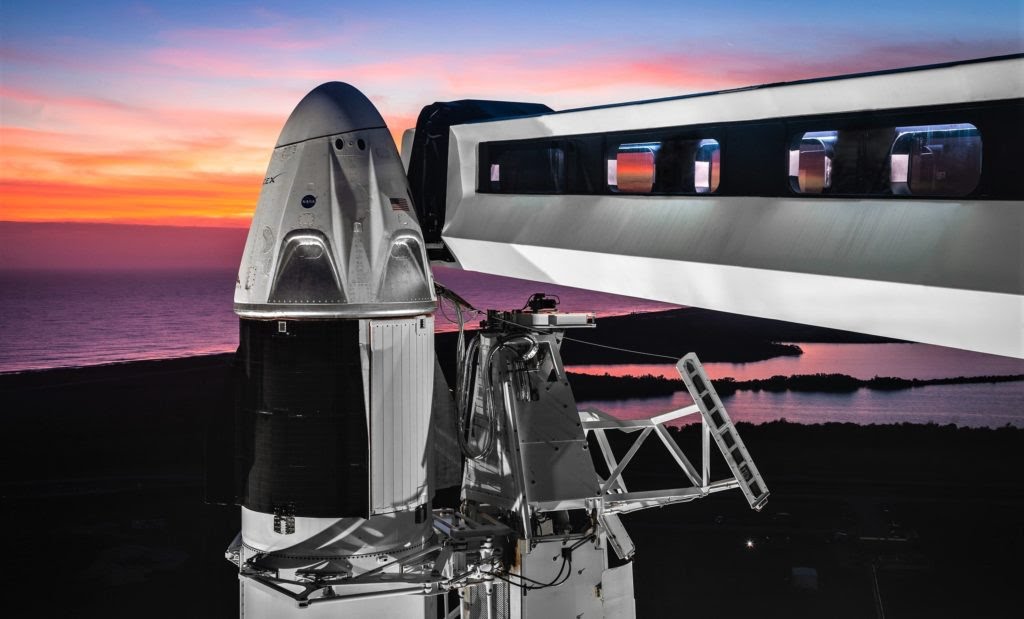
The abort test would involve observation, photography, and debris management associated with the breakup of the Falcon 9 first and second stages.
The launch scenario where an abort is initiated during the ascent trajectory at the maximum dynamic pressure (known as max Q) is a design driver for the launch abort system. It dictates the highest thrust and minimum relative acceleration required between Falcon 9 and the aborting Dragon. As the in‐flight abort would occur during the first stage portion of the launch trajectory, the second stage of Falcon 9 would be simplified
The abort test would start with a nominal launch countdown and release at T-0. The Falcon 9 with the Dragon attached would follow a standard ISS trajectory with the exception of launch azimuth to approximately Mach 1. The Falcon 9 would be configured to shut down and terminate thrust, targeting the abort test shutdown condition (simulating a loss of thrust scenario).
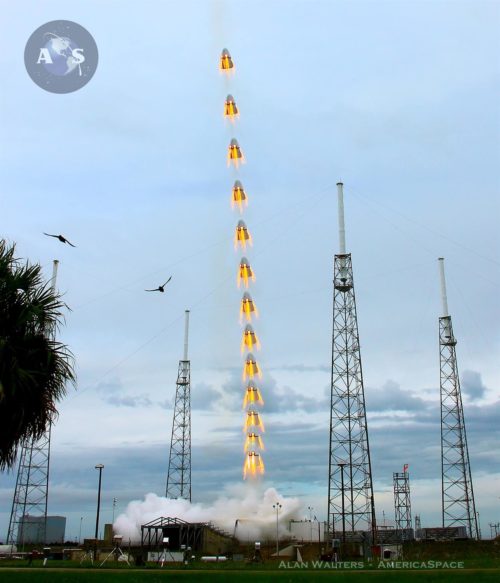
Dragon would then autonomously detect and issue an abort command, which would initiate the nominal startup sequence of Dragon’s SuperDraco engine system. Concurrently, Falcon 9 would receive a command from Dragon to terminate thrust on the nine first stage Merlin 1D (M1D) engines. Dragon would then separate from Falcon 9 at the interface between the trunk and the second stage, with a frangible nut system. Under these conditions, the Falcon 9 vehicle would become uncontrollable and would break apart. SpaceX would not attempt first stage booster flyback to KSC, CCAFS, or a droneship, nor would they attempt to fly the booster to orbit.
Dragon would fly until SuperDraco burnout and then coast until reaching apogee, at which point the trunk would be jettisoned. Draco thrusters would be used to reorient Dragon to entry attitude. Dragon would descend back toward Earth and initiate the drogue parachute deployment sequence at approximately 6 miles altitude and main parachute deployment at approximately 1 mile altitude.
Dragon recovery operations would be very similar to actions for normal Dragon reentry and recovery, although Dragon recovery during the abort test would occur approximately 9–42 miles from shore, and normal Dragon recovery is approximately 200 miles offshore.
The recovery vessel would recover all parachutes deployed by Dragon, as possible, including the two drogue and four main parachutes. Recovery of the drogue parachute assembly would be attempted if the recovery team can get a visual fix on the splashdown location.
However, because the drogue parachute assembly is deployed at a high altitude, it is difficult to locate. In addition, because of the size of the assembly and the density of the material, the drogue parachute assembly becomes saturated within approximately one minute of splashing down and begins to sink. This makes recovering the drogue parachute assembly difficult and unlikely.
The Dragon test vehicle is intended to represent the final flight configuration of Dragon-2. Systems, subsystems, and components critical to the success of in-flight abort would be in the final configuration. Non-critical systems would either be eliminated or simplified to reduce the complexity of the ground refurbishment process to conduct the abort test.
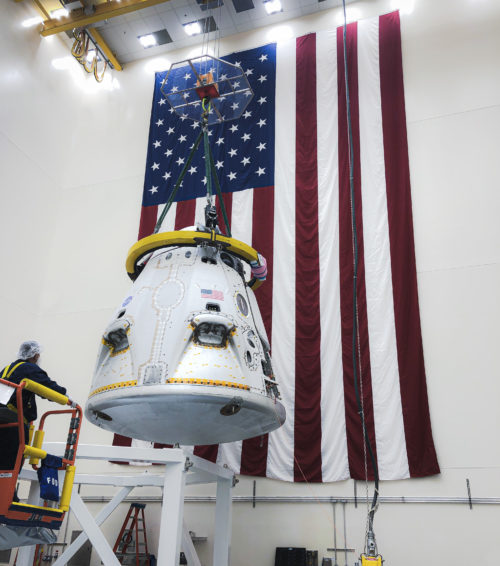
Dragon would contain approximately 5,650 pounds of hypergolic propellant, including approximately 3,500 pounds of dinitrogen tetroxide (NTO) and 2,150 pounds of monomethylhydrazine (MMH). Dragon would contain approximately 2,400 pounds of residual propellant after the abort test.
The booster would be a standard Falcon 9 first stage and configured in an expendable configuration for the abort test. Landing legs and grid fins would be removed.
No booster recovery burns would be attempted. As such, a full triethylaluminum-triethylborane (TEA-TEB) mixture used as a first and second stage ignitor would not be used. The booster would be capable of flying a mission profile that allows for the target abort velocity to be achieved.
The booster would include nine M1D engines and be configured to perform an ascent abort shutdown. Each engine is propelled by liquid oxygen (LOX) and rocket fuel (RP-1; highly refined form of kerosene) and produces 190,000 pounds of thrust at sea level (for a total of 1.71 million pounds of thrust from all nine engines). The booster would carry the standard set of flight instrumentation.
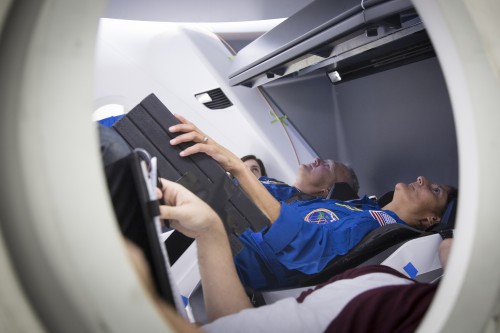
The second stage would be a standard Falcon 9 second stage, with the exception of the M1D vacuum engine. The components essential to propellant loading operations would be carried, but the thrust chamber, turbopump, thrust vector control actuators, and other components required for performing second stage burns, would be omitted, as the mission concludes part-way through the first stage ascent burn. Propellant loading would follow standard loading operations for the second stage.
During the initial flight of the Falcon 9 with the Dragon attached, the flight track would be normal. The separation of Dragon from Falcon 9 would occur approximately between 83 and 100 seconds after launch. Dragon and the trunk would separate from the second stage and continue to coast to its apogee, eventually dropping the trunk and deploying the drogue parachutes.
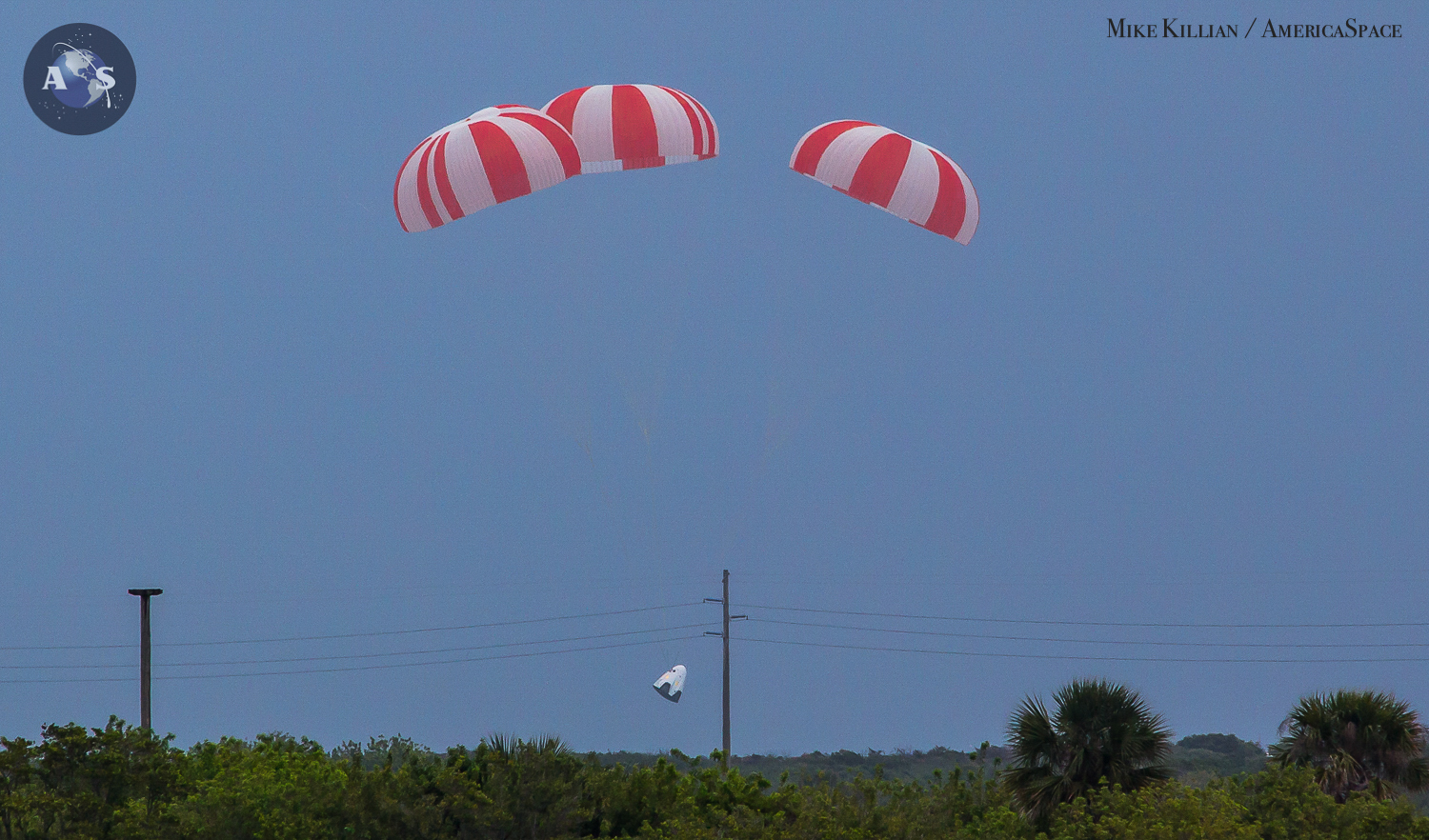
At the point where Dragon and the trunk separate, the first and second stage would become unstable and break up approximately 2–4 miles down range from the shore. After the main chutes deploy, Dragon would drift approximately 3 miles and land approximately 9–42 miles from shore.”
Only after the flight test is complete, and once everything is to NASA’s satisfaction, will a GO be given for SpaceX to fly the first Dragon Riders to the ISS.
.
.
FOLLOW AmericaSpace on Facebook and Twitter!
.
.





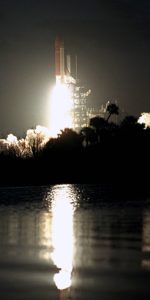
its great that we can use american equipment and know how to get people into space and beyond earth low orbit so russia want a lift we can make you a good deal how’s 15m each rider no extras or frills musk has received millions of tax money to acheive this goal and he did it or so far